Key Takeaway
Bow Pose (Dhanurasana) is a comprehensive backbend that strengthens the back, improves posture, and offers a full-body stretch, making it a valuable addition to any yoga practice for enhanced flexibility and back health.
| BOW POSE | |
|---|---|
| Alternate name: | Dhanurasana |
| Difficulty level: | Intermediate |
| Pose category: | Back muscles (spine) Hamstrings (legs) Glutes (hips) Calf muscles and soleus (lower legs) Shoulder muscles and triceps (arms) Hip flexors (hips) Upper torso muscles (chest) Core muscles (abdomen) Front of the lower leg muscles (lower legs) Quadriceps (thighs) |
| Muscle groups: | Back muscles (spine) Hamstrings (thighs) Glutes (buttocks) Calf muscles and soleus (lower legs) Shoulder muscles (shoulders) Triceps (arms) Hip flexors (hips) Rectus abdominis, internal and external obliques (abdomen) Quadriceps (front of thighs) |
| Physical benefits: | Strengthens back and abdominal muscles; improves posture; stretches hip flexors and chest. |
| Therapeutic applications: | Back pain relief, eases menstrual discomfort. |
| Preparatory poses: | Cat/Cow (Marjaryasana/Bitilasana) Cobra Pose (Bhujangasana) Locust Pose (Salabhasana) |
| Counterposes that follow well: | Child’s Pose (Balasana) Supine Knees to Chest (Apanasana) |
| Chakras activated: | Solar Plexus Chakra (Manipura Chakra) |
| Most helpful prop: |  Yoga strap around feet - aids reach, supports lift. See latest price |
Many people are drawn to yoga for its myriad health benefits. Others find satisfaction in improving flexibility, and creating fun and interesting shapes with their bodies. Dhanurasana, or Bow Pose, is a particular pose that can be impressive, challenging, and satisfying all at once.
Dhanurasana comes from the Sanskrit word for “bow” as the whole body is bent into the shape of an archer’s bow. It’s one of those yoga poses that might look intimidating for people who are new to yoga.
But after reading our in-depth pose breakdown here, you’ll find that Dhanurasana is a wonderful pose to explore in your yoga practice.
Additionally, if you are an experienced yogi or yoga teacher, we’ve provided some illuminating anatomical information to help deepen your understanding of Bow Pose.
Contents
- 1 Anatomy of Bow Pose: A Full Body Asana
- 2 Why should you include Dhanurasana (Bow Pose) in your yoga practice?
- 3 How to do Bow Pose (Dhanurasana)
- 4 Contraindications of Dhanurasana
- 5 Modifications
- 6 Variations of Bow Pose
- 7 Preparatory Poses to Warm-up:
- 8 Counter Poses to Practice After Bow Pose
- 9 Common Questions about Bow Pose
Anatomy of Bow Pose: A Full Body Asana
If Dhanurasana looks like an impressive yoga pose to you — that’s because it is! For new yoga students, Bow Pose feels like a challenge because so many different muscles groups are engaged all at once, some working and some stretching. Here’s a brief look at what’s really going on in Bow Pose:
Working Muscles
- Back muscles (spine extensors and the QL muscle in the low back) engage to lift your upper torso and lengthen your spine.
- Hamstrings activate to bend your knees towards your glutes.
- Glutes engage to extend the hips.
- Muscles on the back side of the lower leg (calf muscle and soleus) work to point the feet
- Muscles on the back of the shoulders draw the shoulder blades together, and along with the triceps work to extend the arms and lift the legs.
Muscles that Lengthen
- Hip flexors lengthen as you bring your body into a curved bow shape.
- All muscles on the front of the upper torso stretch as your chest opens.
- Core muscles (rectus abdominus, internal and external obliques) lengthen deeply the higher you lift your upper body up off the floor.
- Muscles on the front of the lower leg lengthen as you point your feet.
- Front of the thigh (quadriceps) lengthen as you bend your knees and bring your feet towards your glutes.
Clearly, Bow Pose is a complicated and intense pose, which is exactly why you should give it a try!
Why should you include Dhanurasana (Bow Pose) in your yoga practice?
Like many yoga poses, Bow Pose offers many positive effects for both your body and your mind. Bow Pose strengthens not only the back, but tones many other muscle groups as well. Maintaining strength in your back, glutes, and hamstrings is essential to maintaining optimal posture. Simultaneously, giving your deep hip flexors a good stretch can help relieve back pain.
Here are a couple specific physical benefits of practicing Dhanurasana.
Better Back Health
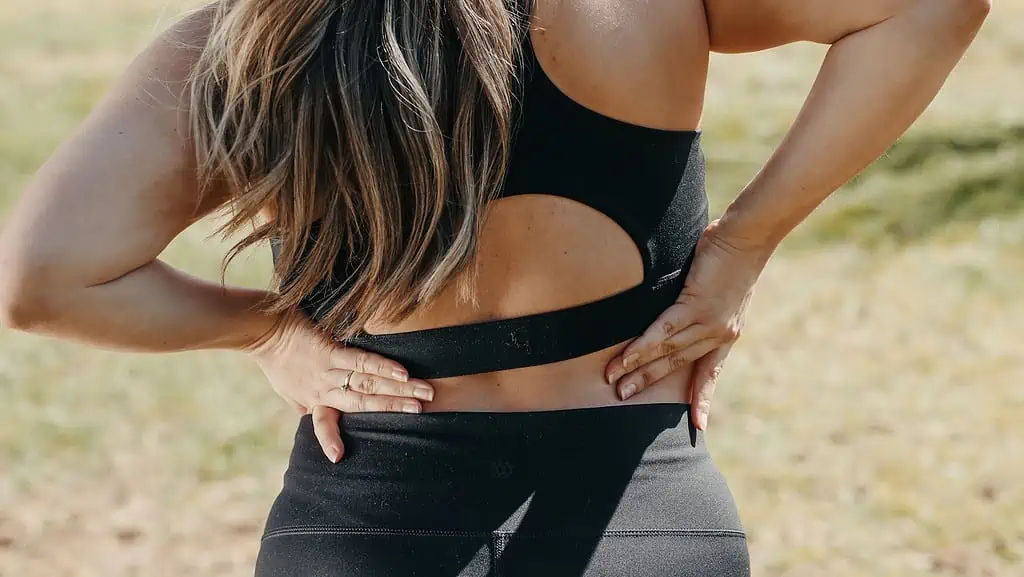
One of the greatest results from regularly practicing this yoga pose is to keep your back in optimum health. Since Bow Pose strengthens both the back and abdominal muscles, it helps improve posture. This is crucial, considering how many of us suffer from adverse effects of a sedentary lifestyle.
For example, when you spend hours at a time seated at a desk in front of a computer, you’ve likely experienced hunched shoulders, stiffness, and lower back pain. As a chest opener, Bow Pose counteracts the slouching effect of sitting at a desk. It also lengthens the front body, especially the hip flexors which can become tight and weak after long periods of sitting.

As with other backbends, Dhanurasana emphasizes spinal extension. It strengthens the spine extensors as you lift your upper body up off of the mat. By keeping your back and spine strong, you improve your spinal mobility and help prevent future injury.
Eases Menstrual Discomfort
Another possibly surprising perk of Dhanurasana is that it can decrease duration and severity of menstrual cramps. Stretching the abdominal muscles relieves pressure on the reproductive organs and increases blood flow to the pelvic region.
Multiple studies show the soothing effects of stretching in relation to menstrual discomfort. In one group, participants reported a marked decrease in period pain after performing abdominal stretches. In another similar study, stretching the abdominal muscles proved just as effective in reducing period pain as taking anti-inflammatory medication.
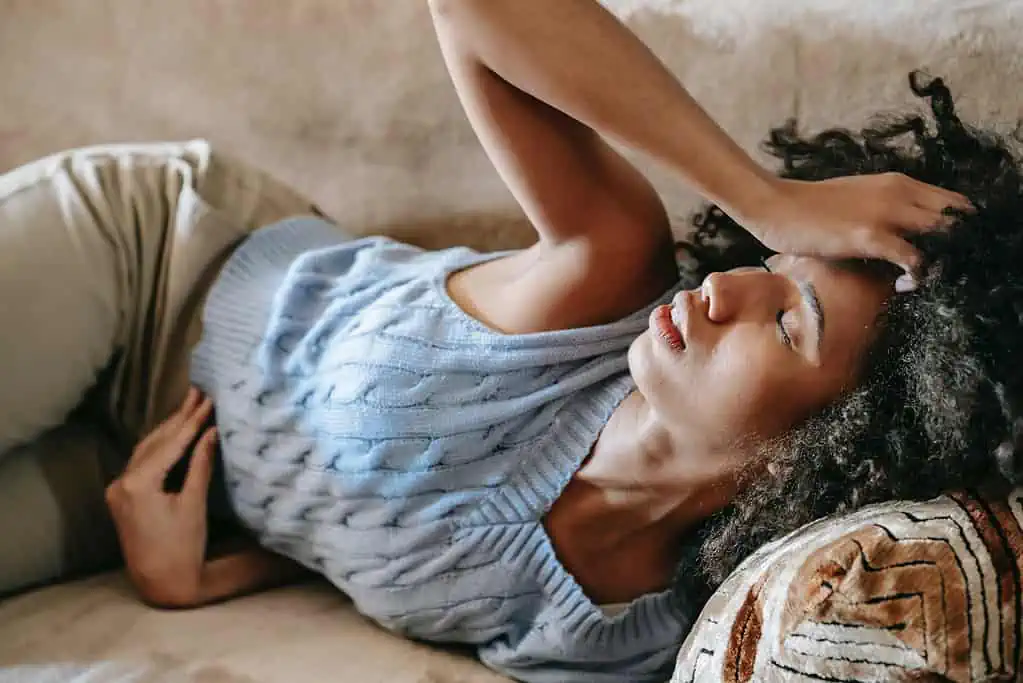
Of course, another well-known outcome of practicing yoga in general is reduction of tension, which is advantageous when dealing with any type of physical pain!
Other Benefits of Bow Pose
If back pain and menstrual cramps are not a concern for you, there are still many other worthwhile reasons to add Dhanurasana into your yoga flow. Results from practicing Bow Pose include:
- Better digestion through massaging abdominal organs
- Stronger hamstrings and glutes
- Improved overall flexibility and mobility
- Stronger core
- Toned leg and arm muscles
- Less fatigue through stimulating adrenal glands
- Increased focus and balance
How to do Bow Pose (Dhanurasana)
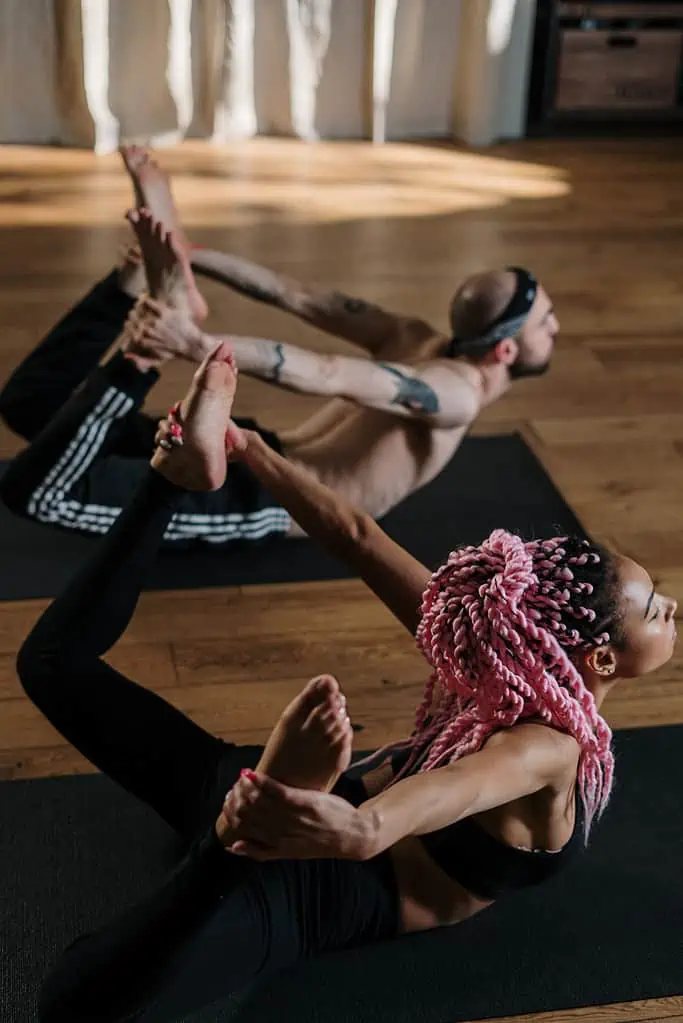
Now that you are familiar with the intention and motivation of this backbend, you’re ready to try it! Here’s how:
- Begin in Crocodile Pose, lying flat in a prone position on your yoga mat with your legs at a hip distance. Fold your arms and stack your forearms underneath your head, creating a shelf for your forehead.
- Rest your forehead on your arms and take a few deep breaths, bringing your attention to your back body.
- Now, bend your knees and bring your feet as close as you can to your glutes.
- Reach your right arm back and grab hold of your right ankle. Be sure that your arm is in internal rotation as you reach back, with the back of your hand facing out.
- Do the same on your other side, reaching your left arm back to grab hold of your left ankle.
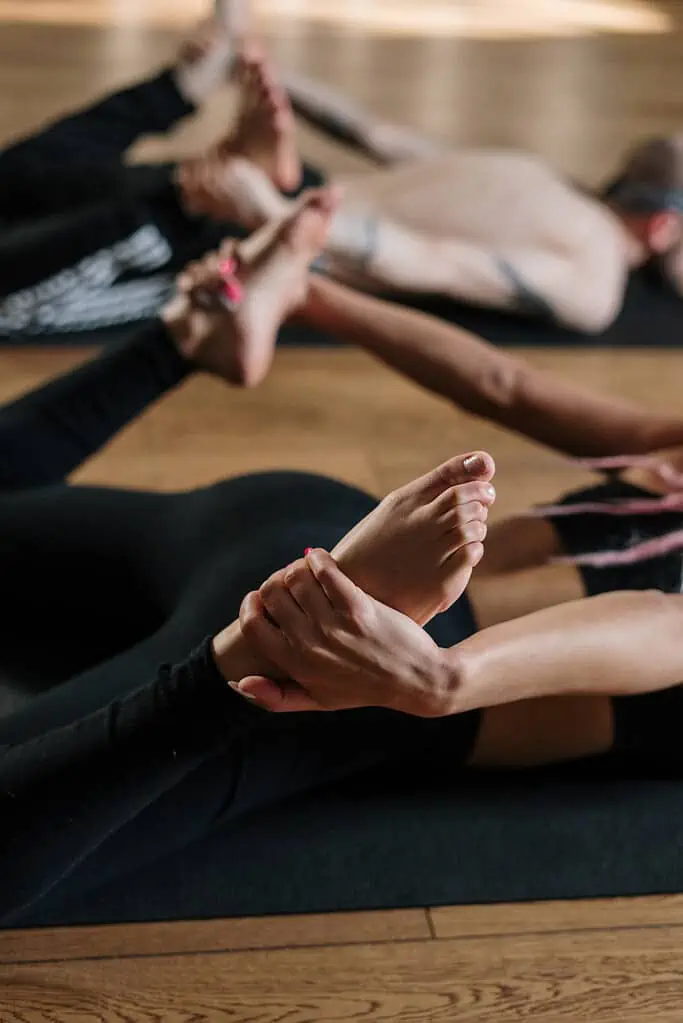
- Pull your low belly in and up to engage the deepest part of your core. This will help protect and stabilize your lumbar spine.
- Now, press your lower legs back into your hands. Lift your upper torso off the floor as your arms straighten.
- Keep your head aligned with your spine, looking straight ahead.
- Squeeze your shoulder blades together and feel your chest open.
- With a firm grip on your outer ankles, feel as though you are kicking your lower legs into your hands, creating resistance. You should feel a stretch in the front of your shoulders.
- Keep trying to lift your lower body up off of the floor as you balance on your lower abdomen, creating the shape of an archer’s bow. Keep your gaze forward.
- When you can lift no higher, hold your Bow Pose for a few seconds, then gently lower your legs and upper body to your mat.
- Carefully release your ankles and extend your legs, returning to Crocodile Pose.
- Mindfully take a few breaths to relax all the muscles of your back.
If you prefer a visual demonstration, check out this quick Bow Pose tutorial:
Alignment Pro-Tips and Teaching Cues
If you are a yoga teacher, or a star yoga student looking to improve your form, here are some important points to keep in mind:
- Legs should be aligned with knees hip-width apart. If the knees are too close together, it may cause pain in the low back.
- Grab hold of the ankles rather than the feet, to be sure your hands don’t slip.
- Use internal rotation as you reach your arms back, palms facing in.
- Avoid external rotation of the legs to prevent pain or pulling in the knees; when you bend your knees, your kneecaps should be pointing down and behind you, rather than out to the sides.
Contraindications of Dhanurasana
Bow Pose requires full body engagement and can be intense. For this reason, it might not be safe for everyone to practice. If you are experiencing any of the following medical conditions, it’s best to skip Bow Pose for now and opt for a more gentle backbend:
- Neck, back, or spinal injury
- Recent abdominal injury or surgery
- Irregular blood pressure (high or low)
- Headache, migraine
- Pregnancy
- Chronic low back pain
- Hernia
Modifications
Although Bow Pose is considered an intermediate yoga pose, that doesn’t mean you can’t give it a try as a beginner! Using props is a safe and simple way to introduce a new pose into your practice.
To make your Bow Pose a bit more comfortable, use a folded blanket under your thighs to help give your legs a little preparatory lift off of the floor. You also might use a blanket underneath yourself to cushion the pelvis.
Another strategy to make Dhanurasana more accessible to you is to use a yoga strap. If you have tight leg muscles and are unable to grab hold of your ankles, you can loop a yoga strap around the tops of your feet. Grab the ends of the strap as close to your legs as possible so your arms are straight, and lift through your upper back.
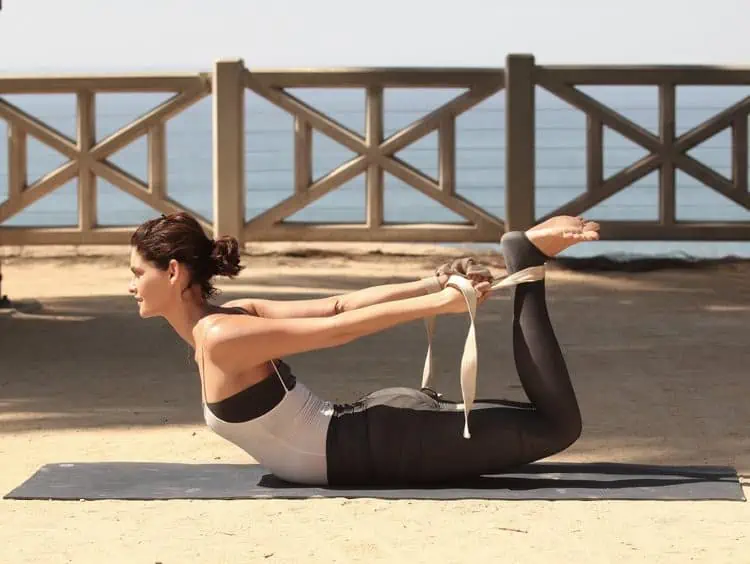
Variations of Bow Pose
No matter where you are in your yoga journey, there are many variations of Dhanurasana (Bow Pose) to expand your experience of this pose.
Half Bow Pose
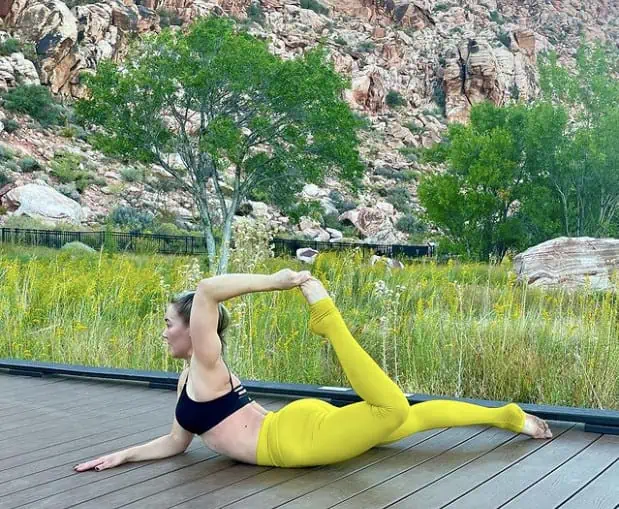
Try this beginner-friendly variation working with only one leg.
- Begin lying on your belly with your legs hip width apart, as you would for regular Bow Pose.
- Come onto your forearms, lifting your head, shoulders, and chest off of the floor.
- Bend your right knee and reach your right arm back. Take hold of your right ankle.
- Apply the same alignment and muscle engagement as detailed in the instructions for Bow Pose.
- Feel the right side of your body open and lengthen, and hold your Half Bow for several breaths.
- Release your right foot gently to the floor, and return to Crocodile Pose.
- When you are ready, try Half Bow Pose on your left side.
Side Bow Pose
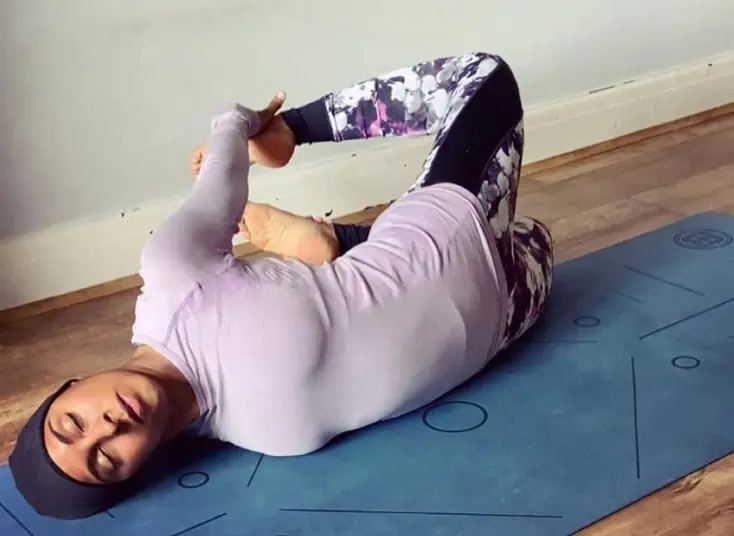
If you’re having trouble getting much lift off of the floor, you can practice the archer’s bow shape while lying on your side. Even if you have a solid bow pose in your yoga practice, this can be a fun variation to change things up!
- Follow the step-by-step instructions to bring yourself into your fullest expression of Dhanurasana.
- Take an inhale, and as you breathe out, dip your right shoulder down and gently roll yourself onto your right side.
- Hold the shape of your body, lying on your right side.
- After a few breaths, release your ankles and return to your belly.
- Repeat Side Bow Pose on your other side, beginning with regular Dhanurasana, then rolling over onto your left side.
Full bow pose
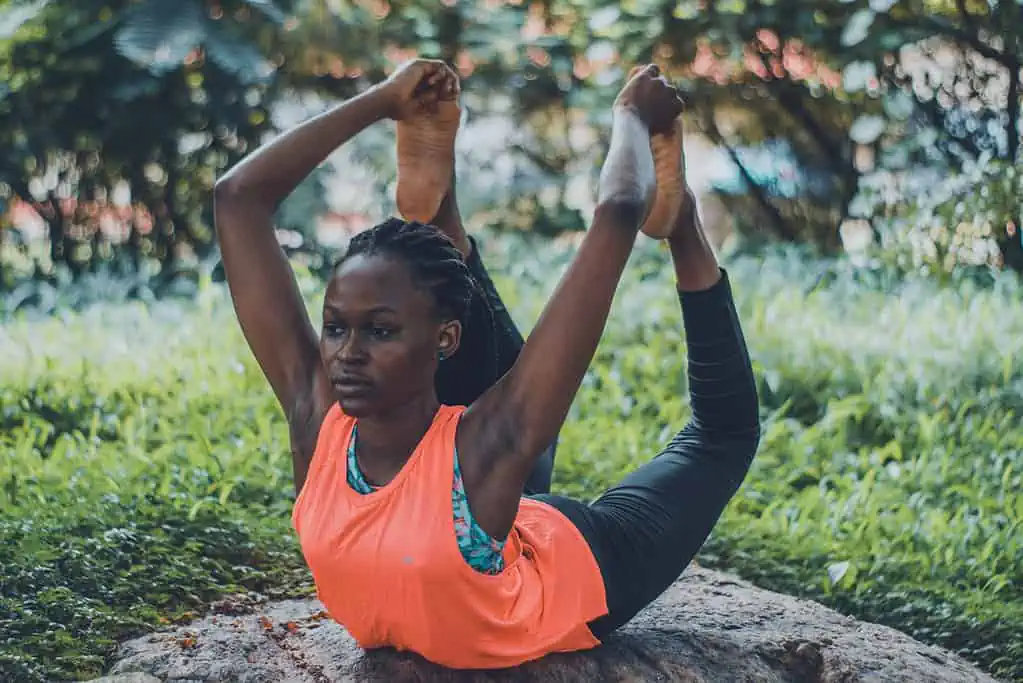
If you are a fan of deep backbends, this advanced version is a wonderful goal to level-up your Dhanurasana and experience a deeper stretch in your front body.
- Begin as you would in regular Bow Pose, knees hip-width apart as you bend your legs to bring your feet towards your glutes.
- Reach your right arm back, this time with external rotation — your palm facing away from your body.
- Grab onto the outer edge of your right foot.
- Repeat with the left arm reaching back and holding onto the left foot.
- With both feet in your hands, start to lift your legs higher as you bring your arms up and behind you.
- Keep your elbows slightly bent, making an open oval shape with your arms and legs connected.
- When you are ready to exit the pose, bend your arms and legs to lower them down a bit, then release your feet gently and return all your limbs to your mat.
Preparatory Poses to Warm-up:
When practicing a backbend like Bow Pose, it is imperative that you warm up specific muscle groups that will be working or lengthening, in order to prevent injury. Here are some preparatory poses you can use to prepare your body for Dhanurasa.
Cat/Cow
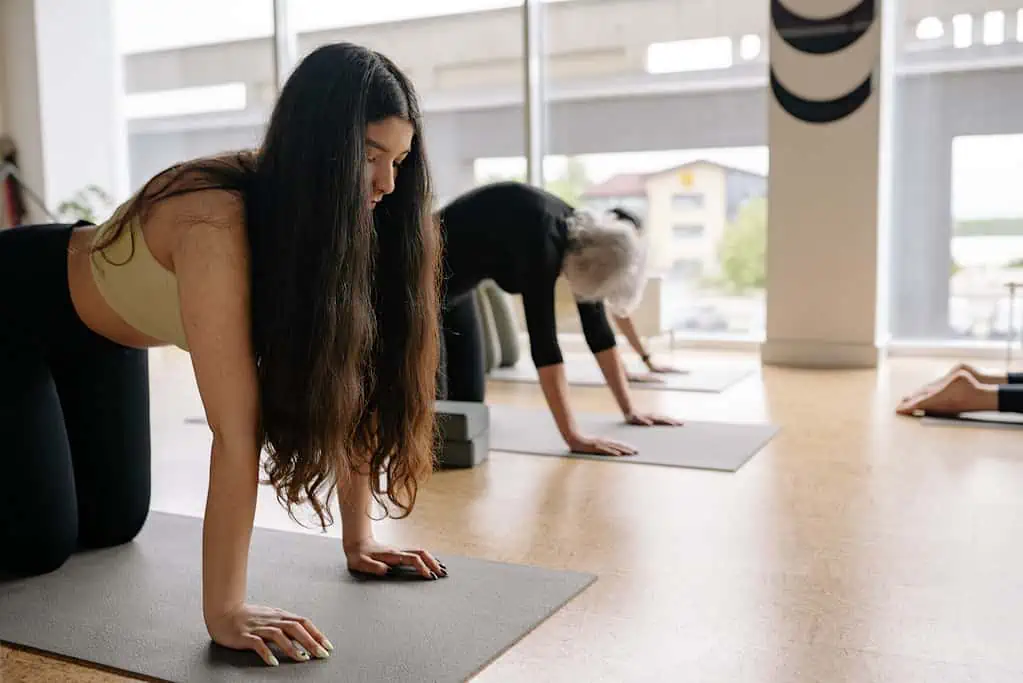
Warm up your spine with a few rounds of Cat/Cow stretch.
- Begin on all fours in a Table Top position.
- Inhale to Cow Pose: drop your belly, tilt your sit bones towards the sky, squeeze your shoulder blades together, and lift your chin slightly.
- Exhale to Cat Pose: round through your whole spine, tuck your tailbone, spread your shoulder blades wide apart, and lower your chin towards your chest.
- Move through a few rounds of Cat/Cow, following your breath.
Cobra Pose
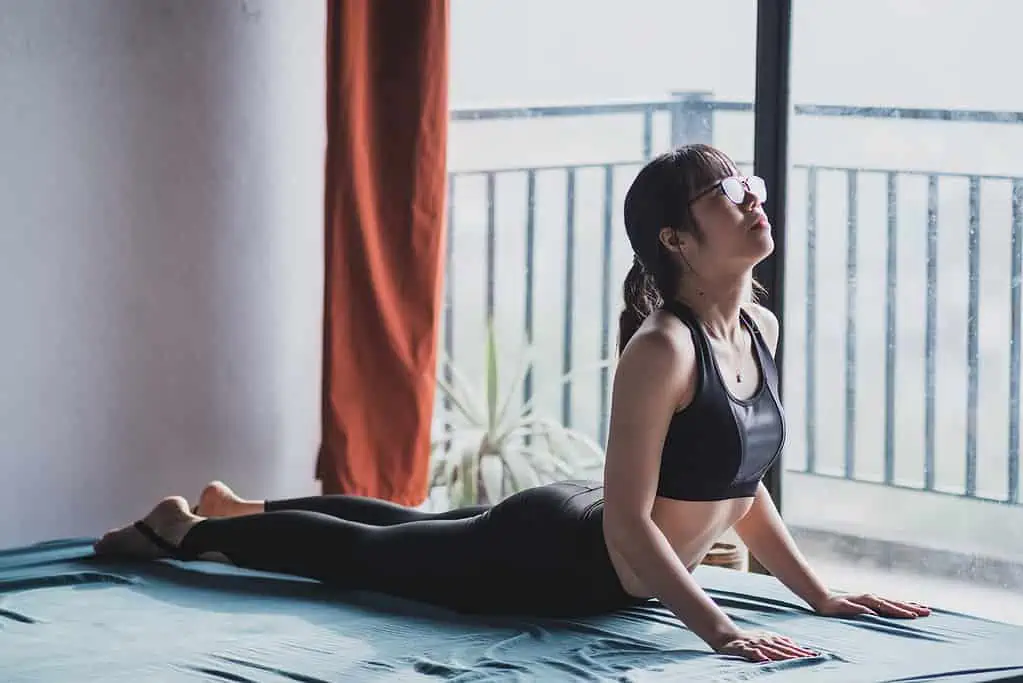
Cobra Pose will help open your upper back and chest in preparation for Bow Pose.
- Begin in a prone position, lying flat on your belly with your legs separated a hip-width distance.
- Bring your hands underneath your shoulders.
- Press the tops of your feet into your mat so your leg muscles are active.
- Press your hands into the floor and keep your elbows close to your body as you lift your head and chest off the floor.
- Hold for 5 or so breaths, then release back down to your belly.
Locust Pose
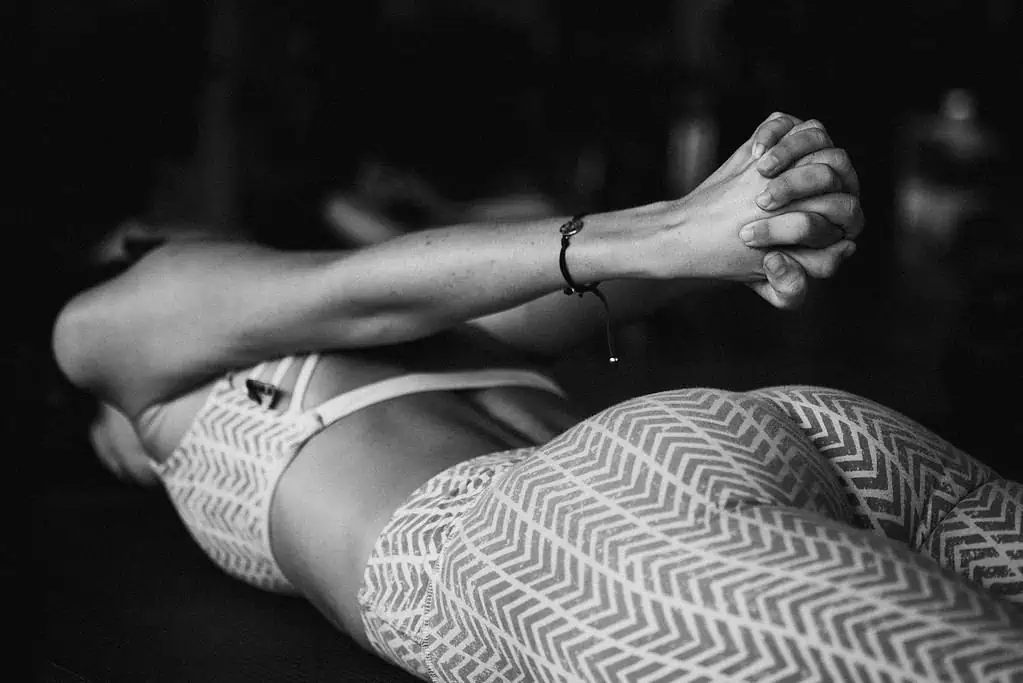
Locust Pose is the next step in warming up your back, both lengthening the spine and strengthening the spine extensors to help prepare you for Dhanurasana.
- Begin lying on your belly with the tops of your feet on the floor and your legs at a hip-width distance.
- Bring your hands underneath your shoulders.
- Come into a Baby Cobra, lifting your head, chest, and shoulders off of the mat.
- Reach your arms behind you and interlace your fingers, making one fist.
- Straighten your arms as much as you can as you squeeze your glutes, engage your leg muscles, and lift your legs off the floor.
- Reach your one fist back towards your feet and squeeze your big toes together.
- Hold for 5 or so breaths, then release back down to your belly and let your entire body relax.
Low Lunge with Quad Stretch
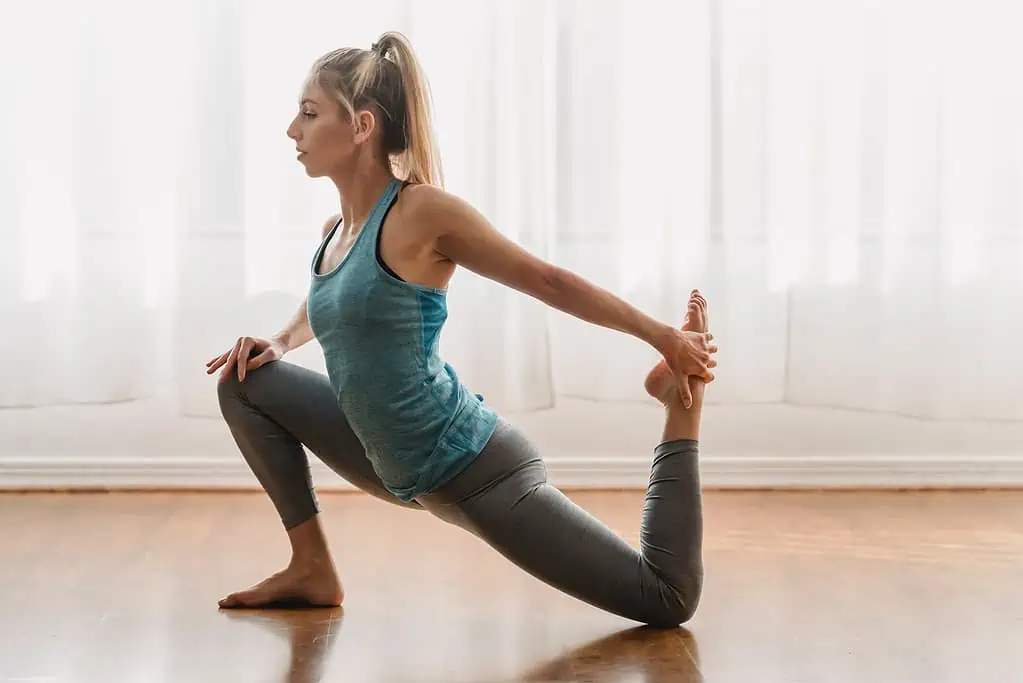
Practice Low Lunge with an added quad stretch to get your lower body ready for Dhanurasana.
- From a kneeling position, bring your left leg forward and plant your foot, keeping your right knee grounded into your mat.
- Square off your hips, drawing your left hip back and right hip forward.
- Bring your hands to the floor, framing your right food.
- Press your tailbone forward and down, sinking your hips toward the floor.
- Bend your right knee, bringing your foot towards your glutes.
- Keep your left hand panted to the inside of your right foot. Reach your right arm back and take hold of your right foot.
- Gently squeeze your right foot towards your glutes to stretch your quad muscle.
- Hold for a few deep breaths, then release your foot and right hand back to your mat.
- Move through Table Top and return to a kneeling position.
- Repeat your Low Lunge and quad stretch on your other side, taking your right leg forward and stretching your left leg.
Counter Poses to Practice After Bow Pose
After such an intense backbend, it’s important to let your back muscles stretch and relax. Here are a couple postures that will feel great in your body after Dhanurasana.
Child’s pose
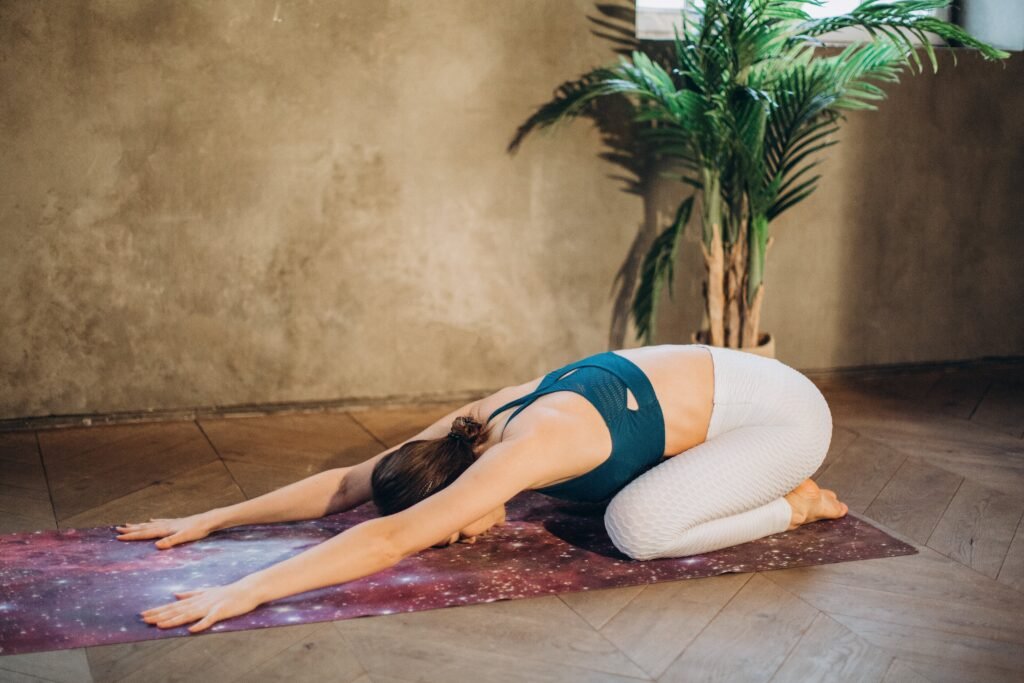
Child’s pose will stretch your back muscles and release your glutes.
- Begin in a kneeling position, sitting on your heels.
- Separate your knees a bit to leave space for the belly.
- Place your hands to the mat, palms facing down and reach your arms forward.
- Bring your forehead gently to the floor.
- Keep reaching your tailbone back towards your heels and breathe deeply.
- When you are ready, walk your hands back in towards your legs to sit yourself upright.
Supine Knees to Chest
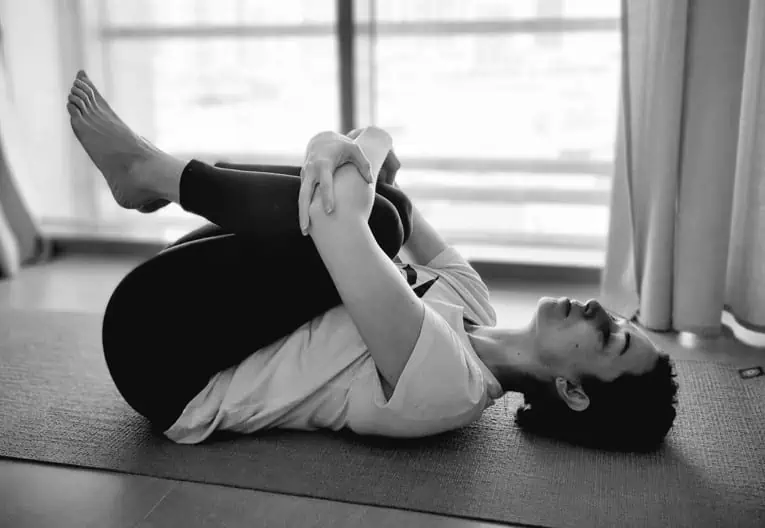
This simple, easy stretch will help gently neutralize your spine after a backbend.
- Begin lying flat on your back.
- Bring both knees in and place one hand on top of each shin.
- Gently squeeze your knees in towards your chest.
- Hold for a few breaths, the mindfully release and extend your legs along your yoga mat, arriving in Savasana.
Common Questions about Bow Pose
Why is Bow Pose good for back pain?
To be clear: if you are experiencing back pain currently due to injury or chronic pain, consult your physician before practicing any back-bending yoga poses. That being said, Bow Pose can help prevent injury by keeping the back and spine strong and mobile. It also engages the glutes and hamstrings, which are important for postural support.
What makes Bow Pose so challenging?
As detailed earlier in this article, your entire body is engaged in Bow Pose, with various muscle groups either working or stretching. It calls for considerable strength and flexibility, which are wonderful goals to work towards in your yoga practice!
Why is Bow Pose important?
Backbends and heart openers like Dhanurasana help counteract sedentary patterns reflected in posture such as hunched shoulders and a sunken chest. If you are like most people and spend a considerable amount of time sitting at a desk, in a car, or looking at your phone, you should consider this pose an essential addition to your yoga practice.


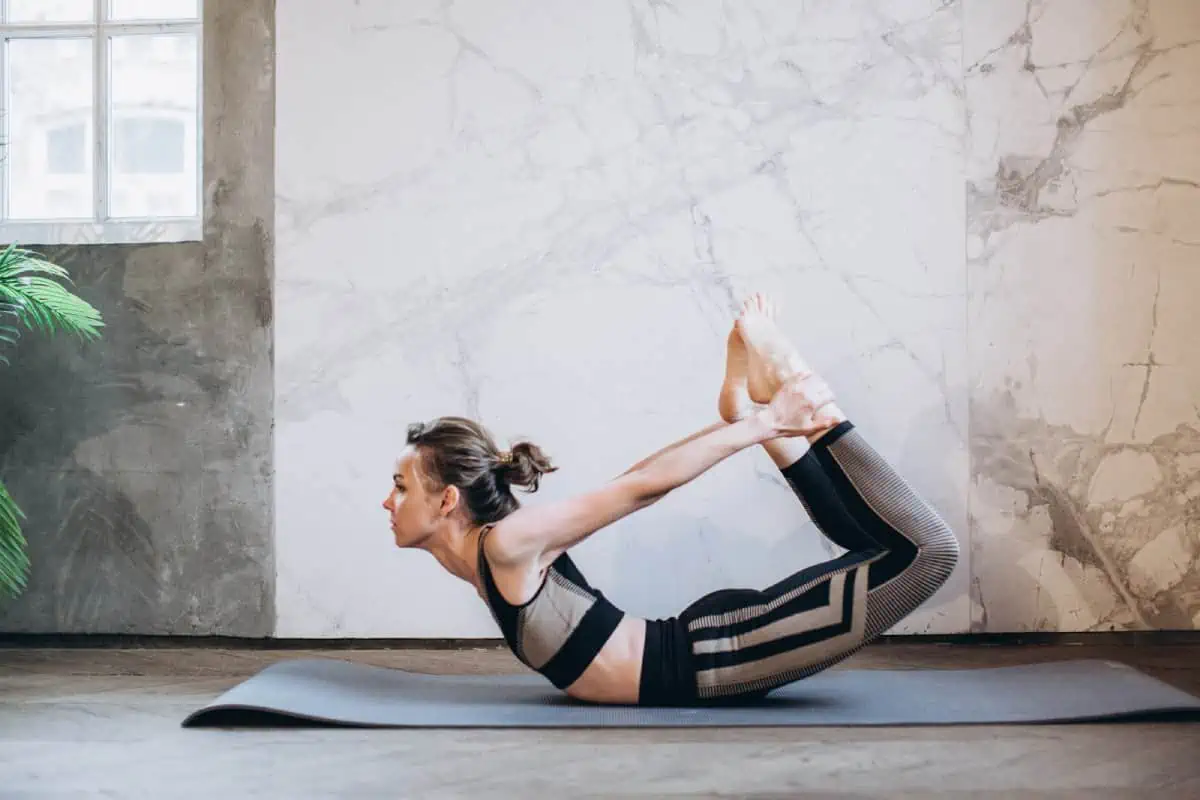
Comprehensive analysis. Bow pose is indeed a great pose when it comes to building strength and flexibility. Thank you for sharing the detailed overview of the advantages of the bow pose and the ways in which one can execute it correctly. A professional touch, while you are trying to do the bow pose, can help you to reach perfection easily. The online yoga classes at cult.fit conducted by experts can carve your way to learn to do a perfect bow pose in no time.